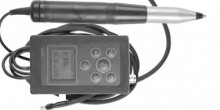77D11 Bearing Tester with Non-Contact Tacho
Ideally, rolling bearing elements are separated by a protective lubricant film, which impedes their collision. However, manufacturing defects, damages, which appear during operation, dirt in the bearing, insufficient or incorrect lubrication – all these factors cause the collision of the bearing elements and, as a result, acoustic oscillations of a wide spectrum are generated in the bearing body.
Specification
Standard Conditions for Operation:
- Operating temperature (device & sensor), -10 to 55°Ñ, (±5)°Ñ;
- Relative humidity 80% at temperature 30 °Ñ;
- Atmospheric pressure, 84 to 106.7 KPa (630 - 800 mm Hg);
- Resonance frequency, 32 kHz;
- Measurement unit, dBi, dBc, dBm;
- Range, max. 99dB;
- Resolution, 1 dB;
- Accuracy, ± 5%;
- Operating temperature (tacho), 10 to 55°Ñ, (±5)°Ñ;
- Tachometer range, 50-30,000rpm;
- Tachometer resolution, 1rpm;
- Tachometer sensing distance, up to 1m;
- Memory capacity, 2MB;
- PC communication port, USB;
System Specification:
- Power supply, 3.6V NiMH rechargeable battery.
- Continuous operation on batteries, not less than 10 hours.
- Current consumption 220V, 50 Hz AC, not more than 5VA.
- The limits of complementary error of the instrument at voltage changing from 3.6Volts to 2.8Volts.
- Probability of no-failure operation, not less than 0.92 per 2000 hrs.
- The average instrument life, not less than 10 years.
- Failure time, 1000 hours. The average failure time is set for stan-dard conditions for operation.
- Dimensions, not more than 60 õ 110 õ 30 (mm).
- Weight, not more than 210 gram.
Delivery Set
- BT-77 w/ rechargeable battery inserted
- Bearing Vibration measuring probe
- IR Tachometer w/ mounting stand
- AC Charger, 220-230Volts
- Liquid maker
- Carrying Case with Foam-insert
- Operating Instructions Manual in CD-ROM
- CD-ROM PC software
- USB PC communication cable
- Maker calibration certificate
Overview on Rolling Bearing Condition Monitoring
Ideally, rolling bearing elements are separated by a protective lubricant film, which impedes their collision. However, manufacturing defects, damages, which appear during operation, dirt in the bearing, insufficient or incorrect lubrication – all these factors cause the collision of the bearing elements and, as a result, acoustic oscillations of a wide spectrum are generated in the bearing body.
A specially designed transducer (patent ¹18652) is used to filter out the part of this spectrum that carries information on the bearing faults detection. The transducer filters those acoustic oscillations which are generated by the bearing defects, and converts them into electronic signal proportional to the magnitude of shock pulse signal, that is amplified and measured by the BT-77 electronic unit in the relative units of decibels (dB).
A real new bearing is just from the beginning of its use, a source of induced vibration, the amplitude of the shock pulse of which is dBi.
The dBi, initial value depends on the large number of factors; however, in practice it is possible to limit them to diameter D (mm) of the neck and its rotating speed N N N (rpm). The value of dBi features the condition of a new correctly installed and lubricated bearing.
The shock pulse amplitude increases as a result of wear and improper use. Shock acceleration amplitude over running the value of dBi - dBsv features a damage, and is used for the evaluation of bearing condition.

